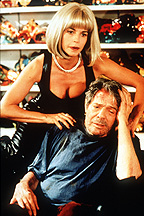FILM NOTES
FILM NOTES INDEX
NYS WRITERS INSTITUTE
HOME PAGE

Three Lives and Only One Death
(French, 1996, 124 minutes, color, 35 mm in French with English subtitles)
Directed by Raul Ruiz
Cast:
Marcello Mastroianni . . . . . . . . . . Mateo Strano/Georges Vickers/Butler/Luc Allamand
Chiara Mastroianni . . . . . . . . . Cecile
Anna Galiena. . . . . . . . . . Tania
Karl Malden . . . . . . . . . . Shooter
Marisa Paredes. . . . . . . . . . Maria
Melvil Poupaud. . . . . . . . . . Martin
The
following film notes were prepared for the New York State Writers
Institute by Kevin Jack Hagopian, Senior Lecturer in Media Studies
at Pennsylvania State University:
 The setting is a recording studio, in 1999, and we are told a tale of death and transfiguration that takes us through the streets of Paris and into the nether reaches of the imagination. This is a triptych of tiny biographies of little men, men whose lives only seem surreal, and distant from ours. In fact, "Mateo Strano," "Georges Vickers," and "Luc Allemand" are all ways of saying ‘everyman.’ As the narrative slowly revolves like a ponderous stage turntable, each character is presented for our curiosity, passes from view, and turns up again in some other guise. Like other great multi-paneled works of the classic European cinema (LA RONDE, BOCCACIO ’70, DEAD OF NIGHT), THREE LIVES AND ONLY ONE DEATH braids one character into another with such irresistibly sweet logic that the life lived the old-fashioned way, linearly, seems hopelessly dull. The world of THREE LIVES AND ONLY ONE DEATH is out of M.C. Escher by way of Buster Keaton via O. Henry, a universe that turns in on itself confusingly, like a figure-ground exercise, but one that adheres to rigid rules, however mysterious and unarticulated. The whole confection is reassuringly animated by the casual, unassuming Absurdist grace of the inimitable Marcello Mastroianni.
The setting is a recording studio, in 1999, and we are told a tale of death and transfiguration that takes us through the streets of Paris and into the nether reaches of the imagination. This is a triptych of tiny biographies of little men, men whose lives only seem surreal, and distant from ours. In fact, "Mateo Strano," "Georges Vickers," and "Luc Allemand" are all ways of saying ‘everyman.’ As the narrative slowly revolves like a ponderous stage turntable, each character is presented for our curiosity, passes from view, and turns up again in some other guise. Like other great multi-paneled works of the classic European cinema (LA RONDE, BOCCACIO ’70, DEAD OF NIGHT), THREE LIVES AND ONLY ONE DEATH braids one character into another with such irresistibly sweet logic that the life lived the old-fashioned way, linearly, seems hopelessly dull. The world of THREE LIVES AND ONLY ONE DEATH is out of M.C. Escher by way of Buster Keaton via O. Henry, a universe that turns in on itself confusingly, like a figure-ground exercise, but one that adheres to rigid rules, however mysterious and unarticulated. The whole confection is reassuringly animated by the casual, unassuming Absurdist grace of the inimitable Marcello Mastroianni.
But if Mateo, Georges, and Luc are everyman, they are also no-man. Each arrives and leaves the film trailing wonderment, and leaving wisps of self-doubt in his wake. Mateo’s apartment seems to be an anteroom to the twilight zone, a place whose walls dissolve, a place that creates anonymity where once congenial society prevailed. Disarmingly, a "For Rent" sign marks the turnstile between here and then. Georges, the lecturer in "negative anthropology," takes up a new life with a shrug, entering into an uncommon bond with a lovely prostitute. And Luc, a prosperous businessman, offers his largesse to a young couple who have ample cause to wish their benefactor had minded his own damn business. And just who is that butler. . . Soon, one life folds into another, and characters take short hops from one dimension to another. Transformation seems ongoing in THREE LIVES AND ONLY ONE DEATH, and change perpetual.
This was one of Marcello Mastroianni’s last roles, and he inhabits the multiplied main parts with the grace of Cary Grant, and the comic timing of Alec Guinness. The death of the title, ironically, proved to be Mastroianni’s; he died shortly after finishing the film. This deft little film suffered at the box office because of Mastroianni’s passing; going to the film seemed slightly ghoulish, apparently. That’s a shame, because Mastroianni’s career wove together the strands of the postwar European art cinema into an unlikely narrative, a story by turns elegant, cynical, and transcendant, a story seen through the weary eyes of an aging roué. THREE LIVES AND ONLY ONE DEATH leaves us wondering—maybe Mastroianni did not die at all, but merely disappeared down this cinematic rabbit hole, into a looking glass world from where he smiles at us even now.
— Kevin Hagopian, Penn State University
For additional information, contact the Writers Institute at 518-442-5620 or online at https://www.albany.edu/writers-inst.